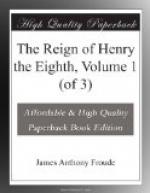Such a rehearsal of the English Reformation was witnessed at the close of the fourteenth century, confused, imperfect, disproportioned, to outward appearance barren of results; yet containing a representative of each one of the mixed forces by which that great change was ultimately effected, and foreshadowing even something of the course which it was to run.
There was a quarrel with the pope upon the extent of the papal privileges; there were disputes between the laity and the clergy,—accompanied, as if involuntarily, by attacks on the sacramental system and the Catholic faith,—while innovation in doctrine was accompanied also with the tendency which characterised the extreme development of the later Protestants—towards political republicanism, the fifth monarchy, and community of goods. Some account of this movement must be given in this place, although it can be but a sketch only. “Lollardry"[449] has a history of its own; but it forms no proper part of the history of the Reformation. It was a separate phenomenon, provoked by the same causes which produced their true fruit at a later period; but it formed no portion of the stem on which those fruits ultimately grew. It was a prelude which was played out, and sank into silence, answering for the time no other end than to make the name of heretic odious in the ears of the English nation. In their recoil from their first failure, the people stamped their hatred of heterodoxy into their language; and in the word miscreant, misbeliever, as the synonym of the worst species of reprobate, they left an indelible record of the popular estimate of the followers of John Wycliffe.
The Lollard story opens with the disputes between the crown and the see of Rome on the presentation to English benefices. For the hundred and fifty years which succeeded the Conquest, the right of nominating the archbishops, the bishops, and the mitred abbots, had been claimed and exercised by the crown. On the passing of the great charter, the church had recovered its liberties, and the privilege of free election had been conceded by a special clause to the clergy. The practice which then became established was in accordance with the general spirit of the English constitution. On the vacancy of a see, the cathedral chapter applied to the crown for a conge d’elire. The application was a form; the consent was invariable. A bishop was then elected by a majority of suffrages; his name was submitted to the metropolitan, and by him to the pope. If the pope signified his approval, the election was complete; consecration followed; and the bishop having been furnished with his bulls of investiture, was presented to the king, and from him received “the temporalities” of his see. The mode in which the great abbots were chosen was precisely similar; the superiors of the orders to which the abbeys belonged were the channels of communication with the pope, in the place of the archbishops; but the elections in themselves were free, and were conducted in the same manner. The smaller church benefices, the small monasteries or parish churches, were in the hands of private patrons, lay or ecclesiastical; but in the case of each institution a reference was admitted, or was supposed to be admitted, to the court of Rome.




